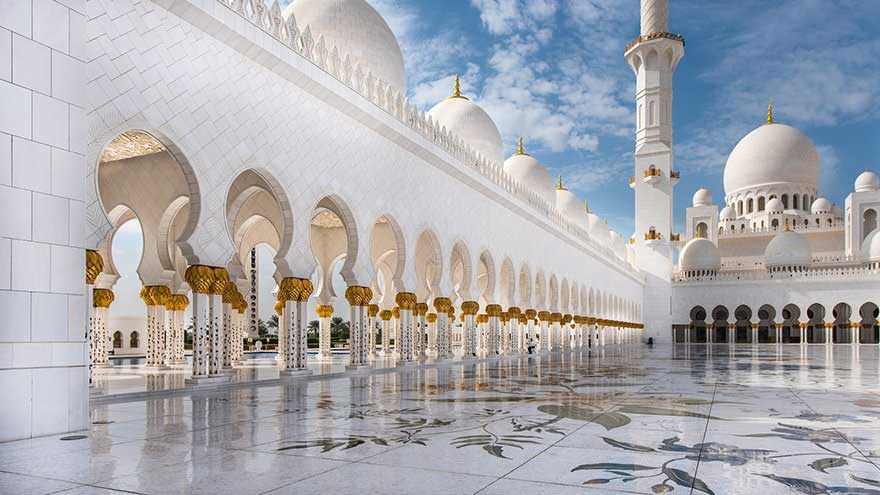Exploring the Beautiful Mosques of Dubai: A Journey Through Spiritual and Architectural Splendor
Dubai, renowned for its towering skyscrapers and luxury, also harbors a deep-rooted Islamic culture reflected in its beautiful mosques. These sacred spaces blend traditional and modern architectural styles, showcasing the city’s devotion and the diversity of Islamic design. Whether you’re a traveler seeking spiritual experiences or simply intrigued by architecture, Dubai’s mosques offer a peaceful and inspiring journey. Here’s a guide to some of the most notable mosques in Dubai.
1. Jumeirah Mosque: Dubai’s Most Photographed Mosque
One of Dubai’s most iconic and accessible mosques, the Jumeirah Mosque stands as a symbol of Islamic openness and hospitality. Built entirely from white stone, the mosque is designed in the medieval Fatimid tradition, with elegant minarets and a grand dome that radiates at sunset. Known for being open to non-Muslim visitors, the Jumeirah Mosque offers guided tours, giving visitors insight into Islamic culture, traditions, and architecture.
The mosque’s architectural details are captivating, with delicate carvings and patterns that reflect classic Islamic art. Visitors are encouraged to ask questions during tours, making it an educational and welcoming experience for all.
2. Al Farooq Omar Bin Al Khattab Mosque: Dubai’s Blue Mosque
Inspired by Istanbul’s Blue Mosque, the Al Farooq Omar Bin Al Khattab Mosque is one of Dubai’s largest mosques, and its Ottoman-style design stands out with its blue and white tiled exterior. The mosque has a capacity of over 2,000 worshippers and features a series of intricate mosaics, beautiful calligraphy, and vibrant colors.
Visitors to the mosque will find a tranquil courtyard and a rich interior adorned with Quranic verses. Known for its community outreach, Al Farooq Mosque also welcomes non-Muslims for guided tours, offering a window into Islamic culture and art.
3. Grand Mosque: A Historical Landmark in Old Dubai
Located in Bur Dubai near the Dubai Creek, the Grand Mosque is a significant historical landmark that embodies traditional Emirati architecture. Originally built in 1900, the mosque has been restored multiple times, maintaining its historical essence. Its 70-meter minaret is one of the tallest in Dubai and stands out among the wind towers and old souks nearby.
The Grand Mosque has nine large domes and 45 smaller ones, creating an elegant and harmonious structure. Although the mosque is open only to Muslim worshippers, the surrounding area offers beautiful views, particularly in the evening when the mosque is illuminated, adding a serene glow to Old Dubai.
4. Iranian Mosque: A Unique Persian Influence
In the Al Fahidi district, the Iranian Mosque (Ali ibn Abi Talib Mosque) is a stunning example of Persian-style architecture. Its vibrant turquoise and blue tiles, intricate floral patterns, and calligraphy are unmistakably Persian, setting it apart from other mosques in Dubai. This Shia mosque, with its detailed mosaics and colorful facade, provides a unique glimpse into the Persian influence in Dubai’s Islamic architecture.
While entry is generally restricted to worshippers, visitors can appreciate the mosque’s striking exterior and distinct architectural style, which is different from the more typical Emirati or Ottoman designs.
5. Sheikh Zayed Mosque in Abu Dhabi: A Short Journey from Dubai
While technically not in Dubai, the Sheikh Zayed Grand Mosque in nearby Abu Dhabi is easily accessible from Dubai and is one of the most spectacular mosques in the world. Known for its enormous scale and exquisite design, the mosque can accommodate over 40,000 worshippers and features 82 domes, over 1,000 columns, and the world’s largest hand-knotted carpet.
The Sheikh Zayed Mosque combines modern and classical Islamic architectural elements from various regions, including Moorish, Mughal, and Ottoman styles. Non-Muslims are welcome to visit, and guided tours provide a comprehensive look at the mosque’s design, history, and religious significance.
6. Maryam Umm Eisa Mosque: A Symbol of Religious Harmony
Dubai is known for its commitment to tolerance and religious harmony, and the Maryam Umm Eisa Mosque (Mary, Mother of Jesus Mosque) stands as a symbol of this dedication. Originally named Al Mushrif Mosque, it was renamed in 2017 as a gesture of respect for religious diversity and interfaith understanding. The mosque has become a beautiful reminder of Dubai’s spirit of inclusivity.
Located in Al Mushrif, this mosque’s design is traditional, with a peaceful ambiance that makes it a welcoming space for worshippers. While it is primarily open to Muslims, the mosque’s significance transcends religious boundaries and embodies Dubai’s cultural openness.
Experiencing Dubai’s Mosques: Tips for Visitors
If you’re planning to visit mosques in Dubai, keep in mind that they are primarily places of worship, so visitors should dress modestly and behave respectfully. Some mosques offer abayas (traditional dress) for women at the entrance, along with headscarves. Non-Muslims should always check if the mosque they plan to visit is open to the public and if guided tours are available.
Visiting these beautiful mosques in Dubai offers a profound look into Islamic culture and the UAE’s unique architectural heritage. Each mosque, whether historic or modern, reflects the city’s dedication to faith, inclusivity, and the preservation of Islamic art and tradition. Exploring these sacred spaces offers a deeper appreciation of Dubai’s multifaceted culture, leaving visitors with both spiritual insights and visual memories.
Exploring the Beautiful Mosques of Dubai: A Journey Through Spiritual and Architectural Splendor


0 Comment